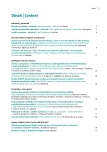Gene mutations connected to Waldenstöm macroglobulinemia
Authors:
Kateřina Kutálková 1; Lenka Sedlaříková 1,2; Zdeněk Adam 3; Sabina Ševčíková 1,2
Authors‘ workplace:
Babákova myelomová skupina, Ústav patologické fyziologie LF MU Brno
1; Oddělení klinické hematologie FN Brno
2; Interní hematologická a onkologická klinika LF MU a FN Brno, pracoviště Bohunice
3
Published in:
Vnitř Lék 2016; 62(1): 40-43
Category:
Reviews
Overview
Waldenstöm macroglobulinemia (WM) is a rare lymphoproliferative disorder, currently classified as a monoclonal gammopathy, with incidence rate of 3 per million. The disease is characterized by presence of clonal B lymphocytes in the bone marrow and by presence of monoclonal immunoglobulin IgM in serum. It is mostly an indolent disorder, with median overall survival 6 years. Molecular pathogenesis of WM remains unclear, but deletion of 6q and 13q, trisomy of chromosomes 4 and 8 seem to be typical. Mutations of MYD88L265P and CXCR4WHIM are very common for WM and affect growth and survival of malignant cells. This work is aimed at the current knowledge of chromosomal aberrations and gene mutations connected to the pathophysiology of WM.
Key words:
chromosomal aberrations – somatic mutations – Waldenström macroglobulinemia
Sources
1. Adam Z, Šmardová J, Ščudla V. Waldenstrőmova makroglobulinémie – klinické projevy a diferenciální diagnostika a prognóza nemoci. Vnitř Lék 2007; 53(12): 1325–1337.
2. Owen RG, Pratt G, Auer RL et al. Guidelines on the diagnosis and management of Waldenstrom macroglobulinaemia. Br J Haematol 2014; 165(3): 316–333.
3. Adam Z, Pour L, Krejčí M et al. Léčba Waldenströmovy makroglobulinemie – zkušenosti jednoho pracoviště. Vnitř Lék 2009; 55(11): 9–1.
4. Ocio EM, Schop RF, Gonzalez B et al. 6q deletion in Waldenström macroglobulinemia is associated with features of adverse prognosis. Br J Haematol 2007; 136(1): 80–86.
5. Braggio E, Keats JJ, Leleu X et al. Identification of Copy Number Abnormalities and Inactivating Mutations in Two Negative Regulators of Nuclear Factor-κB Signaling Pathways in Waldenstrom’s Macroglobulinemia. Cancer Res 2009; 69(8): 3579–3588.
6. Braggio E, Philipsborn C, Novak A et al. Molecular pathogenesis of Waldenstrom’s macroglobulinemia. Haematologica 2012; 97(9): 1281–1290.
7. Cimmino A, Calin GA, Fabbri M et al. miR-15 and miR-16 induce apoptosis by targeting BCL2. Proc Natl Acad Sci USA 2005; 102(39): 13944–13949.
8. Chang H, Samiee S, Li D et al. Analysis of IgH translocations, chromosome 13q14 and 17p13.1(p53) deletions by fluorescence in situ hybridization in Waldenstrom’s macroglobulinemia: a single center study of 22 cases. Leukemia 2004; 18(6): 1160–1162.
9. Schop RFJ, Kuehl WM, Van Wier SA et al. Waldenstrom macroglobulinemia neoplastic cells lack immunoglobulin heavy chain locus translocations but have frequent 6q deletions. Blood 2002; 100(8): 2996–3001.
10. Terre C, Nguyen-Khac F, Barin C et al. Trisomy 4, a new chromosomal abnormality in Waldenstrom’s macroglobulinemia: a study of 39 cases. Leukemia 2006; 20(9): 1634–1636.
11. Treon SP, Xu L, Yang G et al. MYD88 L265P Somatic Mutation in Waldenstrom’s Macroglobulinemia. N Engl J Med 2012; 367(9): 826–833.
12. Ngo VN, Young RM, Schmitz R et al. Oncogenically active MYD88 mutations in human lymphoma. Nature 2011; 470(7332): 115–119.
13. Hunter ZR, Xu L, Yang G et al. The genomic landscape of Waldenstrom macroglobulinemia is characterized by highly recurring MYD88 and WHIM-like CXCR4 mutations, and small somatic deletions associated with B-cell lymphomagenesis. Blood 2014; 123(11): 1637–1646.
14. Kim JA, Im K, Park SN et al. MYD88 L265P Mutations Are Correlated with 6q Deletion in Korean Patients with Waldenstrom Macroglobulinemia. Biomed Res Int: 2014; 2014: 363540. Dostupné z DOI: <http://dx.doi.org/10.1155/2014/363540>.
15. Xu L, Hunter ZR, Yang G et al. MYD88 L265P in Waldenstrom macroglobulinemia, immunoglobulin M monoclonal gammopathy, and other B-cell lymphoproliferative disorders using conventional and quantitative allele-specific polymerase chain reaction. Blood 2013; 121(11): 2051–2058.
16. Puente XS, Pinyol M, Quesada V et al. Whole-genome sequencing identifies recurrent mutations in chronic lymphocytic leukaemia. Nature 2011; 475(7354): 101–105.
17. Treon SP, Cao Y, Xu L et al. Somatic mutations in MYD88 and CXCR4 are determinants of clinical presentation and overall survival in Waldenstrom macroglobulinemia. Blood 2014; 123(18): 2791–2796.
18. Jimenez C, Sebastian E, Chillon MC et al. MYD88 L265P is a marker highly characteristic of, but not restricted to, Waldenstrom’s macroglobulinemia. Leukemia 2013; 27(8): 1722–1728.
19. Kucia M, Jankowski K, Reca R et al. CXCR4-SDF-1 signalling, locomotion, chemotaxis and adhesion. J. Mol. Histol 2004; 35(3): 233–245.
20. Nagasawa T, Hirota S, Tachibana K et al. Defects of B-cell lymphopoiesis and bone-marrow myelopoiesis in mice lacking the CXC chemokine PBSF/SDF-1. Nature 1996; 382(6592): 635–638.
21. Zou YR, Kottmann AH, Kuroda M et al. Function of the chemokine receptor CXCR4 in haematopoiesis and in cerebellar development. Nature 1998; 393(6685): 595–599.
22. Busillo JM, Benovic JL. Regulation of CXCR4 signaling. Acta-Biomembr 2007; 1768(4): 952–963.
23. Cao Y, Hunter ZR, Liu X et al. The WHIM-like CXCR4(S338X) somatic mutation activates AKT and ERK, and promotes resistance to ibrutinib and other agents used in the treatment of Waldenstrom’s Macroglobulinemia. Leukemia 2015; 29(1): 169–176.
24. Pasqualucci L, Trifonov V, Fabbri G et al. Analysis of the coding genome of diffuse large B-cell lymphoma. Nat. Genet 2011; 43(9): 830–837.
25. Redon R, Ishikawa S, Fitch KR et al. Global variation in copy num
Labels
Diabetology Endocrinology Internal medicineArticle was published in
Internal Medicine

2016 Issue 1
Most read in this issue
- Toxic epidermal necrolysis
- Changes in the prognosis and treatment of Waldenström macroglobulinemia. Literature overview and own experience
- Significance of alanine aminotransferase screening in blood donors for risk reduction of hepatitis B and C transmission by haemotherapy
- A rare case of mobile atherosclerotic plaque with a high embolic potential in the femoral artery
